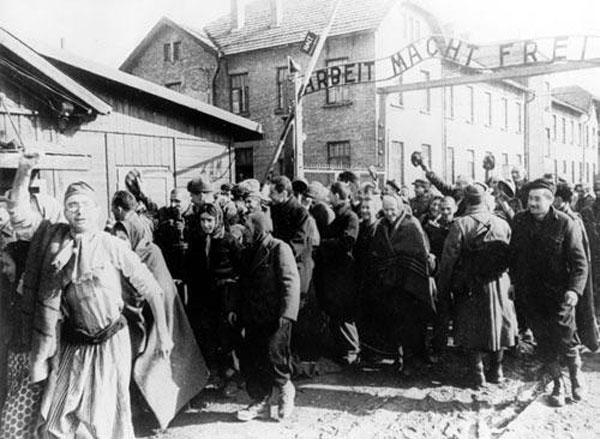Defend the Rights of Prisoners
• Illinois Prisoners on Hunger Strike Against Torture of Solitary Confinement
• Obama Administration Refuses to Provide Cost of Guantánamo, Demands Dismissal of Lawsuit
• Public Dollars Used to Guarantee Profits of Private Prison Industry
Remembering the Holocaust
• Commemoration of Those Murdered by the Nazis
• Imbue with New Life the Clarion Call of Never Again!
Illinois Prisoners on Hunger Strike
Against Torture of Solitary Confinement
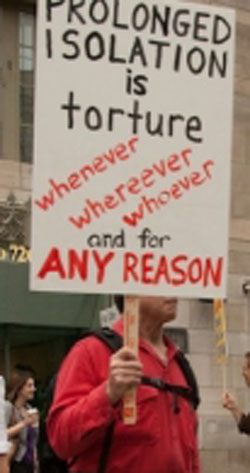 About 15 prisoners in the High Security Unit at Menard Correctional Facility in Chester, Illinois, began a hunger strike January 15, 2014. They were joined by supporters who rallied outside the prison January 27 with a banner saying “We Support the Hunger Strikers.” Prisoners expressed their appreciation, organizing to shout out to demonstrators, “No due process, no peace.” Prison officials responded by disrupting the rally. Since that time petitions are circulating and additional actions have been taken to support the prisoners.
About 15 prisoners in the High Security Unit at Menard Correctional Facility in Chester, Illinois, began a hunger strike January 15, 2014. They were joined by supporters who rallied outside the prison January 27 with a banner saying “We Support the Hunger Strikers.” Prisoners expressed their appreciation, organizing to shout out to demonstrators, “No due process, no peace.” Prison officials responded by disrupting the rally. Since that time petitions are circulating and additional actions have been taken to support the prisoners.
The prisoners are protesting the torture of solitary confinement and other conditions in the prison, such as the lack of hot water and blankets. Many of those at Menard were transferred from the Tamms Correctional Center, a “supermax” prison that was forced to closed. Many have been kept in solitary and are being forced to go through an arbitrary nine-month program in solitary before even beginning to get normal privileges. They were given no notice that they would be placed in solitary, no hearing to contest it, and no reason for it — all required by law. The strike is rejecting these arbitrary measures and the solitary confinement that comes with it. International standards consider 15 days of solitary as torture.
As has been common in other hunger strikes by prisoners, such as those in California last year, as soon as the strike was declared prisoners reported guards shaking down their cells and sending those refusing food to the medical staff. As one example, guards pushed, cuffed, slammed, stomped and kicked prisoner Armando Velasquez, according to letters from hunger strikers. Velasquez has not been seen since, being moved to the Health Care Unit. The unit does not have a surveillance camera and is often used not to provide care but to further brutalize the prisoners.
Prior to the strike the prisoners filed numerous grievances, demanding hot water. One grievance stated that cells had been without hot water for 48 days. The cells themselves are also without adequate heat and blankets, making them very cold, particularly given the harsh weather in January. Prisoners are also asking for basic cleaning supplies for their cells and elimination of the rodent-vermin infestation. The prison has begun to respond with cleaning supplies, but the main demands of ending solitary confinement and heat and hot water have not been met.
Prisoners are anticipating the possibility that they will be force-fed, as has occurred with strikers in California and at Guantánamo. By international standards and medical ethics, prisoners have the right to decide whether or not to accept force feeding. However, prison authorities, often backed up by judges, have imposed it as a way to render the strikes less effective and further humiliate and torture the prisoners.
According to those working with the prisoners, they issued the following proposal to Warden Harrington January 26, 2014.
1. Begin giving the inmates in Administrative Detention informal face-to-face 90-day review hearings and issue them a written disposition stating the basis for whatever decision is reached.
2. Within 30 days, pass out an orientation manual for inmates who are in Administrative Detention or Segregation status.
3. Implement a Behavior Incentive Program that allows inmates who are housed in high security the opportunity to earn the privilege of buying limited food items and coffee.
4. Continue to work on resolving grievances, including weekly rounds by the Major and/or Warden to prevent issues from piling up.
“Once the informal face-to-face hearings begin, we will take your word that the other issues are going to be addressed and we will ALL come off our hunger strike.”
Nine hunger strikers have decided to go without liquid as well as food and their physical condition could deteriorate rapidly. According to an update February 7 by Tom Shear, the Illinois Department of Corrections (IDOC) Director of Communications, "Nine offenders remain on hunger strike. . . . starting today [February 7], they did show signs of dehydration. They apparently stopped taking in water yesterday [February 6] and it takes 36-48 hours for THAT to evidence itself, which is pretty quick. So, we’ll admit them to the infirmary as a precaution.”
The hunger strikers remain determined and are asking people to call or write Menard Correctional Center Warden Rick Harrington, and contact Illinois Governor Pat Quinn to demand an end to the torture of solitary confinement, heat and hot water and that no retaliation be taken against the hunger strikers.
[TOP]
Obama Administration Refuses to Provide Cost of Guantánamo, Demands Dismissal of Lawsuit
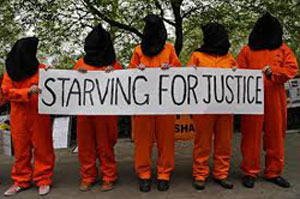 The Obama administration is refusing to provide how much it spent to build the secret prison facility at Guantánamo where supposedly the “worst” prisoners are being held. Guantánamo is notorious for its torture and for keeping hundreds guilty of no crime in indefinite detention. The administration has also asked a federal court to dismiss a lawsuit by a Miami Herald reporter demanding documents that would reveal the public dollars spent on Camp 7.
The Obama administration is refusing to provide how much it spent to build the secret prison facility at Guantánamo where supposedly the “worst” prisoners are being held. Guantánamo is notorious for its torture and for keeping hundreds guilty of no crime in indefinite detention. The administration has also asked a federal court to dismiss a lawsuit by a Miami Herald reporter demanding documents that would reveal the public dollars spent on Camp 7.
In a filing Friday, the Justice Department said that the Pentagon had found just one document that would provide information relevant to a 2009 Freedom of Information Act request reporter Carol Rosenberg filed seeking that cost figure. That document was exempt from disclosure, the filing said, because it contained details of internal deliberations and the names of many officials who were entitled to privacy.
The Justice Department also made a separate secret filing with the court that provided more details on why the document should remain secret. That filing was not shared with Rosenberg’s attorneys, and its contents are unknown. It was made ex parte, meaning without Rosenberg’s lawyers being given a copy, and in camera, meaning it was not part of the public court file and had been shared only with the judge. The Justice Department said the document was also exempt from disclosure because it had been properly classified and the release of the information it contained “reasonably could be expected to result in damage to the national security.”
Rosenberg, who has covered the detention center at Guantánamo since it opened in 2002, originally had sought the cost of Camp 7, as part of her reporting on how much building and maintaining Guantánamo costs U.S. taxpayers. The Defense -Department had provided construction costs for all other portions of the detention center. When it refused to provide any documents responding to her request for information on Camp 7, Rosenberg sued in federal court in the District of Columbia, accusing the Pentagon in part of not conducting a thorough search for documents.
The information is particularly relevant now because the Southern Command, the military entity that controls Guantánamo, is seeking $49 million to replace the eight-year-old facility, which apparently was built improperly and is suffering from serious structural defects, including a cracked foundation.
The Pentagon has refused to say who originally undertook the work, and its responses to Rosenberg’s FOIA would indicate that it has no record of a construction contract or bidding document for the facility.
In this manner, use of public dollars is being hidden while millions more are being requested to keep a concentration camp in place. Further, the government continues to insist that whatever it wants to keep secret can be kept secret, as supposedly the executive alone knows what does and does not impact national security. This in a situation where the very existence of Guantánamo and government threats to put any it claims are a “threat” in indefinite detention there, has greatly undermined peace and security for the peoples here and worldwide.
[TOP]
Public Dollars Used to Guarantee Profits of Private Prison Industry
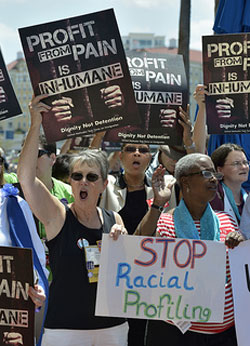 The prison system used to be a last resort, a place you sent people when other forms of punishment were ineffective. Now it has grown into something much darker, and even less rehabilitative.
The prison system used to be a last resort, a place you sent people when other forms of punishment were ineffective. Now it has grown into something much darker, and even less rehabilitative.
Unbeknownst to many, the prison system has become a for-profit business in which inmates are the product — a system that has shocking similarities to another human-based business from America’s past: slavery.
In late 2013, a new report from In the Public Interest (ITPI) revealed that private prison companies are striking deals with states that contain clauses guaranteeing high prison occupancy rates – sometimes 100 percent. This means that states agree to supply prison corporations with a steady flow of residents –whether or not that level of criminal activity exists. Some experts believe this relationship between government and private prison corporations encourages law enforcement agencies to use underhanded tactics – often targeting minority and under served groups – to fill cells.
“The report, ‘Criminal: How Lockup Quotas and ‘Low-Crime Taxes’ Guarantee Profits for Private Prison Corporations,’ documents the contracts exchanged between private prison companies and state and local governments that either guarantee prison occupancy rates (essentially creating inmate lockup quotas) or force taxpayers to pay for empty beds if the prison population decreases due to lower crime rates or other factors (essentially creating low-crime taxes),” reports Salon.
There are now over 2 million people living behind bars in the United States. That is half a million more than China, which has a population five times greater than the U.S. Many are incarcerated for non-violent crimes, like the use or possession of marijuana, and other problems that would be far better served through a rehabilitation or education program.
The worst part is that once captured by the prison industry, inmates are forced to work for pennies an hour, providing cheap labor for some of the most profitable enterprises in the world, including the U.S. Military.
According to the Left Business Observer, “The federal prison industry produces 100 percent of all military helmets, ammunition belts, bullet-proof vests, ID tags, shirts, pants, tents, bags, and canteens. Along with war supplies, prison workers supply 98 percent of the entire market for equipment assembly services; 93 percent of paints and paintbrushes; 92 percent of stove assembly; 46 percent of body armor; 36 percent of home appliances; 30 percent of headphones/microphones/speakers; and 21 percent of office furniture.”
When you can get that kind of labor for less than a dollar a day, it is hard to see the government’s motivation for incarcerating fewer people. And it is all done at the taxpayer’s expense.
[TOP]
Commemoration of Those Murdered by the Nazis
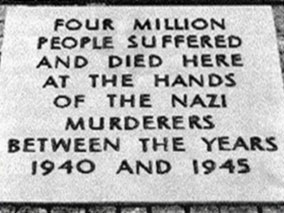
![]()
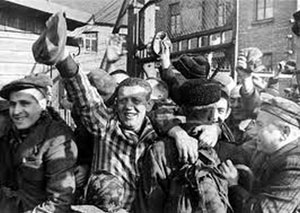
Left: Memorial plaque to those killed by the Nazis in Auschwitz, put in place in 1948 and removed in 1989. Right: Soviet Red Army liberates Auschwitz prisoners January 27, 1945.
On Holocaust Remembrance Day, January 27, the day in 1945 that Soviet troops liberated prisoners from the Nazis’ Auschwitz prison camp, peace- and justice-loving people of the world join all those whose families suffered so greatly under the Holocaust, a program of systematic state-sponsored murder by the Hitlerite Nazis and their allies, the Italian fascists and Japanese militarists. The word “Holocaust” must be understood in its broadest sense as referring to the mass murder of all those who were persecuted, imprisoned, tortured and murdered by the Nazis in Germany and the countries it occupied, especially the Jews and others targeted for extinction including the Roma and many Slavs as well as political opponents, particularly communists and resistance fighters. So too the Japanese militarists carried out the Nanjing Massacre and many other atrocities in China and throughout Southeast Asia, while to this day they owe reparations to the Koreans for the crimes committed against them.
The Western powers initially colluded with Nazi Germany with the hopes that it would wipe out the Soviet Union. U.S. monopolies such as General Motors, Ford, and ITT built military equipment for the Nazis. Standard Oil, Dupont, Alcoa, and General Electric made huge profits collaborating with the Nazis throughout the war. IBM helped the Nazis organize the systematic looting and subjugation of Poland. After the war, the U.S. brought thousands of known Nazis to the U.S. For example, SS Sturmbannführer Dr. Werner von Braun, who was put in charge of the U.S. missile program, oversaw the Nazis’ Mittelwerk rocket factory, which used slave labor from Nazi concentration camps. At the same time, the Western powers also wanted to crush Germany, because it threatened their economic and political interests. The German Nazis wanted to crush everyone, especially the Soviet Union and, as the war progressed, they hoped for Western assistance to do so. Thus revanchism, war and aggression were the order of the day, instead of all countries sorting out matters on the basis of opening society’s path to progress.
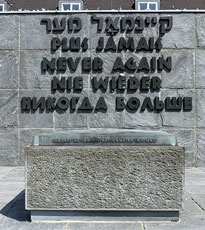
![]()
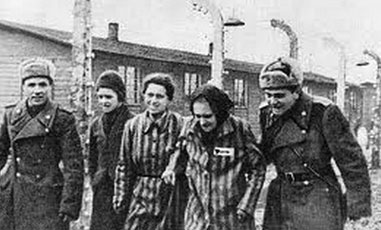 Left: Memorial to the victims of Nazi atrocities at the site of the former Dachau concentration camp representing the demand of the world's people to never again permit the rise of fascism. Right: Auschwitz prisoners with their liberators of the Soviet Red Army.
Left: Memorial to the victims of Nazi atrocities at the site of the former Dachau concentration camp representing the demand of the world's people to never again permit the rise of fascism. Right: Auschwitz prisoners with their liberators of the Soviet Red Army.
In opposing the murderous Hitlerites, a great and heroic role was played by the anti-fascist resistance, especially in the Soviet Union, and by the brave fighters for all the resistance movements in Germany and the occupied countries, as well as the liberating armies from all countries which fought the Hitlerites, the Italian fascists and Japanese militarists, including the British, Canadians and Americans. The living memory of many Jews from Eastern Europe of their direct experience with the Soviets in particular is very positive. Besides the undying gratitude of the world’s people for the sacrifices the Soviet Union made, such as at the Battle of Stalingrad and the Battle of Kursk, many Jews and others were provided asylum or were liberated by the Red Army, which they recall with utmost fondness and gratitude. At the same time, because of the influence of Cold War anti-communism and Zionism, some have the tendency to spout anti-communist cold war ideology against the former Soviet Union, or what to this day is called Stalinism to connote oppression and dictatorship. It is all done in a manner which is irrational and completely at odds with their actual experience.
After the war the mantle of the Hitlerite atrocities was inherited by the Anglo-Americans who betrayed the cause for which the people of their own countries sacrificed their lives to liberate humankind from the scourge of fascism. First they created a civil war in Greece killing communist fighters and demanding that all resistance fighters disavow communism and the resistance struggle and espouse the regime of the fascist military junta imposed on them. Then they adopted the Cold War anti-communist ideology to criminalize communism and disorient the generations that suffered so much so that they blame some abstract human nature for the atrocities, instead of the system of economic and political power concentrated into the few hands of a financial elite, which sought domination in order to solve its problems.
In the post-war period the crimes committed during the Second World War were systematically used by the Anglo-American powers to stop the peoples from moving forward in a manner that favors them and ensures such things are never repeated. Disinformation was spread on a massive scale so as to justify creating the state of Israel as a bastion of Anglo-American imperialism in the Middle East. This was done in a manner that was to create a permanent state of no-war-no-peace so as to deprive the Palestinian people of their homeland and right to self-determination and also suppress the striving of the peoples of the entire Middle East to empower themselves. This has led to prolonged suffering of a kind which itself represents the attempted genocide of a people. (TMLWeekly, cpcml.ca)
[TOP]
Imbue with New Life the Clarion Call
of Never Again!
On January 27, 1945, the advancing Soviet Red Army entered the Nazis’ Auschwitz II-Birkenau extermination camp, liberating more than 7,000 prisoners, most of whom were ill or dying. The prisoners were liberated as the Red Army was inflicting one defeat after another on the German troops, driving the Hitlerites steadily backward until the final demise of the Third Reich in Berlin on May 9, 1945. Recognizing the great significance of the liberation of Auschwitz, in 2005 the United Nations General Assembly officially designated January 27 as the International Day of Commemoration in memory of the many millions of people murdered by the Nazis in their bloodthirsty quest for world domination.
Auschwitz, Nazi Germany’s largest concentration camp complex, was built by the Nazis from 1940-42 in annexed Polish areas about 50 km (30 miles) west of Krakow. By 1942, the Nazis had built over 300 concentration camps in Germany and the occupied territories.[1] The Auschwitz complex consisted of the main camp Auschwitz I, the Auschwitz II-Birkenau extermination camp where 90 per cent of prisoners died, and Auschwitz III-Monowitz, which supplied slave labor for the German chemical monopoly I.G. Farben (IGF). Over forty smaller sub-camps exploited prisoners as slave labor in various industrial plants, armaments factories, coal mines, construction sites and farms. At first only Poles were imprisoned but later Soviet prisoners of war, Romanies (“gypsies”) and people of other nationalities were also incarcerated.
Financed by a loan from the Deutsche Bank, IGF built the Buna Chemical Plant that made synthetic oil and rubber from coal at Auschwitz III-Monowitz. IGF paid 100,000 Reichmarks each year to the Schutzstaffel (SS), the paramilitary organization mainly responsible for Nazi war crimes, to assure a continuous supply of fresh slave labor for the Buna plant while also being “relieved” of unfit inmates. At its peak, the Auschwitz IGF factory used 83,000 slave laborers and prisoners, of which an estimated 25,000-35,000 died. The “unfit” were shipped to Auschwitz-Birkenau, the extermination camp, where 90 per cent of the prisoners were gassed to death using the pesticide Zyklon B, manufactured by an IGF subsidiary.[2] Zyklon B was also used to exterminate about 80,000 prisoners at the Majdanek concentration camp near Lublin, Poland, liberated by the Soviet Red Army in July 1944, and thousands of prisoners at Sachsenhausen camp, north of Berlin, liberated by the Soviet Red Army and the Polish 2nd Infantry Division in April 1945.
A Soviet document of May 6, 1945, officially acknowledged by the Nuremberg War Crimes trials (1945-49), established that the Nazis exterminated four million people at Auschwitz alone, through execution, torture, starvation, illness, exhaustion and murderous medical experiments. From 1948-1989 a commemorative monument erected at the camp site honored the four million victims. Trying to diminish the enormity of Nazi crimes, the imperialists later reduced the Auschwitz deaths to 1.5 million, the “official” number that was inscribed on the new Auschwitz memorial in January 1995. The arbitrary reduction in numbers created a propaganda windfall for the neo-Nazis whose big lie is that the Nazis and their collaborators did not murder anybody.
The Anglo-American forces, well aware of what was taking place at Auschwitz, made no effort to assist the prisoners by, for example, strategically bombing the camp, dropping weapons to the prisoners, providing air cover for an escape, organizing an assault to free the prisoners or even bombing the railway lines that took prisoners to the camp. The main person who blocked U.S. assistance was banker John J. McCloy, the U.S. Assistant Secretary of War. McCloy, who shared a box at the 1936 Berlin Olympics with Adolf Hitler, was legal counsel for I.G. Farben from 1936-40. In the 1950s, McCloy pardoned and released all the Nazi war criminals convicted at the Nuremberg Trials, including the I.G. Farben directors. McCloy was also chairman of the Rockefellers’ Chase Manhattan Bank, which, as the Chase National Bank, had helped the Nazi regime exchange marks for dollars. McCloy was also a lobbyist for the Rockefellers’ Standard Oil (now Exxon), which had secret wartime agreements with I.G. Farben.
Today, as we commemorate the victims of the Nazis, we are duty-bound to note the prominence of the same Nazi banking and industrial interests today, as well as the prominence of their Anglo-American collaborators who also profited handsomely from the widespread depredations of the Nazis, even while claiming to oppose them. It is not enough just to be concerned with the fact that these industry and banking magnates established Auschwitz and other concentration camps and benefited from their slave labor and extermination programs. It is critically important to be aware of what they and their political representatives are up to today, not only in Germany but in the U.S., Canada and other countries, in order to make sure that Auschwitz and other such brutal events never happen again.
A fitting way for workers and youth to mark the 69th anniversary of the liberation of Auschwitz by the Red Army is by taking stock of attempts by current governments to resurrect Nazi war criminals by claiming that they were just ordinary people who fell victim to the “crimes” of so-called totalitarian communism. The imperialists and their political representatives are arrogantly campaigning to have monuments built to actually commemorate such war criminals, paid for by the people. They are also attacking workers, gutting social programs, supporting aggressive war abroad and glorifying it at home, criminalizing dissent, and building more prisons. Why are they doing these things? What aims do they serve today and why should it concern not only the working class and youth but people from all backgrounds, including all those who sacrificed in the Second World War to rid the world of the Nazi menace? The sinister direction of [the imperialists] calls for increased vigilance and for a need to imbue with new life the clarion call of Never Again!
Notes
1. Concentration camps were first used by the U.S. colonialists against Native Americans and by the British imperialists in the Second Boer War, 1899-1902.
2. Zyklon B produced deadly hydrocyanic acid, imitating the process used in U.S. prison executions from 1924 to 1999.
[TOP]

